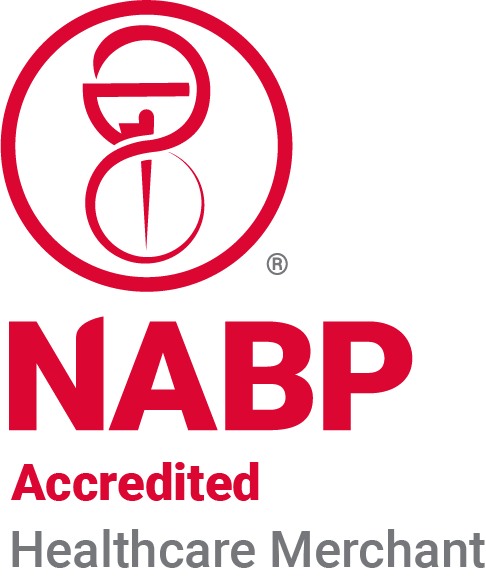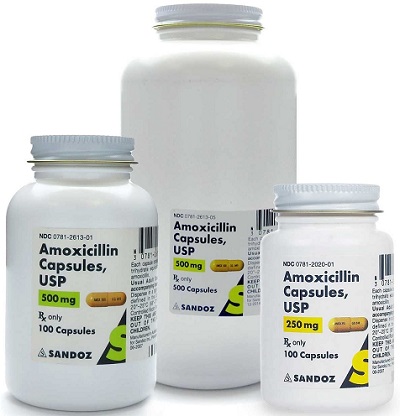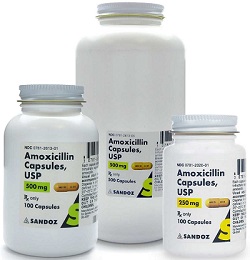Providing Quality & Trust
Amoxicillin Capsules
Sandoz
$12.95 - $18.50
$12.95 Each
Detailed Description
Amoxicillin (a-mox-i-sill-in)
What is Amoxicillin?
Amoxicillin is a broad-spectrum antibiotic which provides bactericidal activity against a wide range of common gram-positive and gram-negative pathogens. Amoxicillin has bactericidal activity against susceptible organisms similar to that of ampicillin.
It acts by inhibiting the biosynthesis of bacterial cell wall mucopeptides. Most strains of the following gram-positive and gram-negative bacteria have demonstrated susceptibility to amoxicillin, nonpenicillinase-producing staphylococci, alpha- and beta-hemolytic streptococci, Streptococcus faecalis, Escherichia coli and Proteus mirabilis.
Amoxicillin does not resist destruction by penicillinase; therefore, it is not effective against penicillinase-producing bacteria, particularly resistant staphylococci. Most strains of Enterobacter and Klebsiella and all strains of Pseudomonas are resistant.
Amoxicillin may be given without regard to meals because it is stable in gastric acid. It is rapidly absorbed following oral administration and diffuses readily into most body fluids and tissues. It diffuses poorly into the brain and spinal fluid except when the meninges are inflamed. Most of amoxicillin is excreted in the urine unchanged.
How is this medication useful?
In dogs and cats, amoxicillin can be useful to treat infections of the skin, respiratory tract, and urinary tract. Amoxicillin has been used in ferrets to treat ulcers caused by Helicobacter spp infections. The FDA has approved some dosage forms of this drug for use in animals. The FDA allows veterinarians to prescribe and use products containing this drug in different species or for other conditions in certain situations. You and your veterinarian can discuss why this drug is the most appropriate choice.
Uses/Indications:
Although there may be some slight differences in activity against certain organisms, amoxicillin generally shares the same spectrum of activity and uses as ampicillin. Because it is better absorbed orally (in non-ruminants), higher serum levels may be attained than with ampicillin.
Penicillins are usually bactericidal against susceptible bacteria and act by inhibiting mucopeptide synthesis in the cell wall resulting in a defective barrier and an osmotically unstable spheroplast. The exact mechanism for this effect has not been definitively determined, but beta-lactam antibiotics have been shown to bind to several enzymes (carboxypeptidases, transpeptidases, endopeptidases) within the bacterial cytoplasmic membrane that are involved with cell wall synthesis. The different affinities that various beta-lactam antibiotics have for these enzymes (also known as penicillin-binding proteins; PBPs) help explain the differences in spectrums of activity the drugs have that are not explained by the influence of beta-lactamases. Like other beta-lactam antibiotics, penicillins are generally considered more effective against actively growing bacteria.
Contraindications/Precautions:
Penicillins are contraindicated in patients who have a history of hypersensitivity to them. Because there may be cross-reactivity, use penicillins cautiously in patients who are documented hypersensitive to other beta-lactam antibiotics (e.g., cephalosporins, cefamycins, carbapenems).
Do not administer systemic antibiotics orally in patients with septicemia, shock, or other grave illnesses as absorption of the medication from the GI tract may be significantly delayed or diminished. Parenteral (preferably IV) routes should be used for these cases.
Reproductive/Nursing Safety:
Penicillins have been shown to cross the placenta and safe use of them during pregnancy has not been firmly established, but neither have there been any documented teratogenic problems associated with these drugs. However, use only when the potential benefits outweigh the risks.
In humans, the FDA categorizes this drug as category B for use during pregnancy (Animal studies have not yet demonstrated risk to the fetus, but there are no adequate studies in pregnant women; or animal studies have shown an adverse effect, but adequate studies in pregnant women have not demonstrated a risk to the fetus in the first trimester of pregnancy, and there is no evidence of risk in later trimesters.)
In a separate system evaluating the safety of drugs in canine and feline pregnancy, this drug is categorized as in class:
- A (Probably safe. Although specific studies may not have proved the safety of all drugs in dogs and cats, there are no reports of adverse effects in laboratory animals or women.)
Side effects that usually are not serious include:
- Diarrhea, vomiting, and loss of appetite. You don’t have to be overly concerned if you see any of these unless they are severe, worsen, or continue to be a problem.
Contact your veterinarian if this happens.
Adverse Effects/Warnings:
Adverse effects with the penicillins are usually not serious and have a relatively low frequency of occurrence.
Hypersensitivity reactions unrelated to dose can occur with these agents and can be manifested as rashes, fever, eosinophilia, neutropenia, agranulocytosis, thrombocytopenia, leukopenia, anemias, lymphadenopathy, or full-blown anaphylaxis. In humans, it is estimated that up to 15% of patients hypersensitive to cephalosporins will also be hypersensitive to penicillins. The incidence of cross-reactivity in veterinary patients is unknown.
When given orally, penicillins may cause GI effects (anorexia, vomiting, diarrhea). Because the penicillins may also alter gut flora, antibiotic-associated diarrhea can occur, as well as selecting out resistant bacteria maintaining residence in the colon of the animal (superinfections).
High doses or very prolonged use has been associated with neurotoxicity (e.g.,ataxia in dogs). Although the penicillins are not considered hepatotoxic, elevated liver enzymes have been reported. Other effects reported in dogs include tachypnea, dyspnea, edema and tachycardia.
Overdosage/Acute Toxicity:
Acute oral penicillin overdoses are unlikely to cause significant problems other than GI distress, but other effects are possible (see Adverse Effects). In humans, very high dosages of parenteral penicillins, especially in patients with renal disease, have induced CNS effects.
Drug Interactions:
In vitro studies have demonstrated that penicillins can have synergistic or additive activity against certain bacteria when used with aminoglycosides or cephalosporins.
Use of bacteriostatic antibiotics (e.g.,chloramphenicol, erythromycin, tetracyclines) with penicillins is generally not recommended, particularly in acute infections where the organism is proliferating rapidly as penicillins tend to perform better on actively growing bacteria. In low concentrations, certain penicillins (e.g.,ampicillin, oxacillin or nafcillin) may have additive or synergistic effects against certain bacteria when used with rifampin, but there is apparent antagonism when the penicillin is present in high concentrations.
If you have any other questions or concerns about this medication, contact your veterinarian or pharmacist.

Powered by nopCommerce
This site is running in live payment mode. Real payments will be processed.

